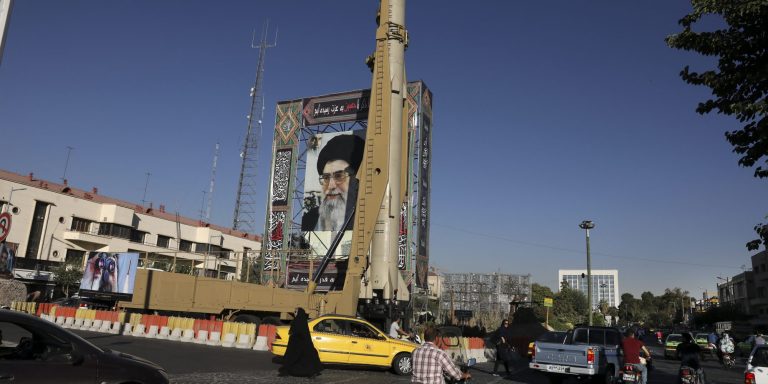INTELBRIEF
October 16, 2019
IntelBrief: Iranian Missiles Are Key to Tehran’s Growing Influence in the Gulf

- The increasing proficiency of Iran’s missile and drone technology is key to Iran’s regional influence and deterrent capability.
- The September 14 Iranian strike on critical Saudi energy infrastructure demonstrated that Iran’s military technology has been underestimated by U.S. and other Western officials.
- Iran’s transfers of short-range ballistic and cruise missiles to its regional allies and proxies enable Iran to project power and credibly threaten major regional conflict if Iran is attacked.
- The unexpected advancement of Iran’s missile technology explains the increased scope of Israeli air strikes on Iran-linked installations in the region.
.
The September 14, 2019 strikes on critical Saudi energy infrastructure at Khurais and Abqaiq prompted a major U.S. and regional reassessment of Iran’s military technology capabilities. The strikes, which were reportedly launched from Iranian territory and not by the Houthis in Yemen as was initially claimed, were precise and devastating in effect. Over half of Saudi oil production was knocked offline, and Saudi officials say that they will not be back to full production until early November. The weapons, which were Land Attack Cruise Missiles (LACMs) assisted by Iranian unmanned aerial vehicles (UAVs), struck nearly all of the 19 sites targeted but also successfully avoided the overlapping U.S.-supplied missile defense network in Saudi Arabia and the broader Persian Gulf region. Iran apparently reverse engineered and extended the range of Soviet-era cruise missiles it acquired years ago, producing Iranian versions with names such as the Meshkat, the Soumar, the Qods-I, and the Ya Ali. Iran was able to develop its UAV capabilities based, in part, on its 2011 capture of an intact U.S. RQ-170 Sentinel drone. Prior to the September 14 attack, virtually all U.S., Western, and regional officials were widely dismissive of Iran’s claims to be capable of conducting a missile strike with that level of precision and effectiveness.
Whereas the September 14 strike demonstrated Iran’s ability to act from its own territory, Tehran has placed even greater focus in recent years on transferring its missile technology to a wide range of regional allies and proxies. Iran has transferred numerous short-range ballistic missiles to the Houthis in Yemen, which Iran is backing in its war on a Saudi-led Arab coalition there. The Houthis have used Iran-supplied ballistic missiles to attack airports and energy infrastructure in southern Saudi Arabia, as well as targets in the United Arab Emirates (UAE) - a Saudi ally in the Yemen campaign. These weapons have enabled Iran and the Houthis to exact a high price on Saudi Arabia and its allies for their Yemen intervention. In June 2019, Iran’s Shia militia proxies in Iraq attacked a Saudi oil pipeline from Iraqi territory. This represented the first confirmed use of that weapon by an Iraqi actor since press reports appeared in late 2018 that Iran had transferred short range missiles to the Iran-backed Katai’ib Hezbollah militia in Iraq, which is a designated foreign terrorist organization by the United States government.
Iran’s supplies of cruise missiles to its allies and proxies have enabled Tehran to extend its reach to regional waterways well beyond the Persian Gulf. Iran bought several hundred C-802 sea-skimming anti-ship cruise missiles from China in the early 1990s, using them to equip its coastal patrol craft in the Gulf. Iran re-engineered these weapons and transferred them to Lebanese Hezbollah, which used them to severely damage an Israeli ship in the Mediterranean during the 2006 Israel-Hezbollah war. Iran has more recently transferred Iran-made versions of these short-range cruise missiles to the Houthis, who used them in 2016 to damage a UAE ship and attack, but miss, a U.S. warship in the Bab-el Mandeb Strait, a key chokepoint for global oil trade. The Houthis also used an Iran-supplied remote-controlled boat to attack a Saudi ship in that waterway.
Iran’s transfer of increasingly precise and capable missiles and related weaponry to its proxies has attracted the attention not only of the Trump administration and the Gulf states, but also of Israel. And Israel has adopted a proactive policy to blunt that threat. Citing the threat from Iran-supplied precision weaponry, during 2018-19 Israel has struck Iranian weapons manufacturing facilities in Syria with increasing frequency. In the summer of 2019, Israel extended that preemptive strike campaign to Hezbollah installations in Beirut, despite the potential for provoking a broader conflict, and to at least one location in Iraq controlled by Iranian proxy militias. In past years, the United States, Israel, and other partners have expressed far greater concern about Iran’s medium-range ballistic missile programs such as Shahab, Ashoura, and Khorramshahr, as well as the military potential of Iran’s space launch vehicle Simorgh program. Whereas these programs offer Iran some deterrent and ‘terror weapon’ capacity, they offer nowhere near the power projection capability that Iran’s shorter-range missile development efforts have demonstrated. Understandably, the U.S. and Israeli emphasis is shifting decisively to countering Iran’s shorter-range missile and its drone efforts accordingly.
.
For tailored research and analysis, please contact: info@thesoufancenter.org